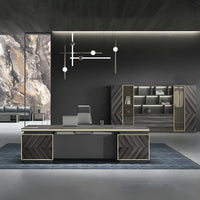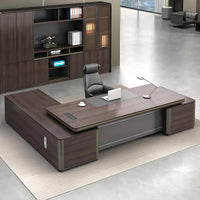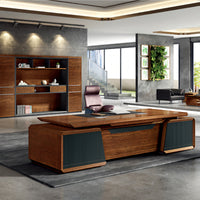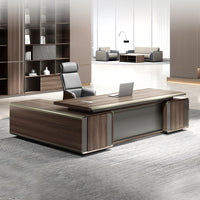The Rise of the Asymmetrical Executive Desk: Redefining Modern Office Aesthetics
kaguyasuContent Menu
● Introduction
● The Evolution of Office Desks
>> Traditional to Modern
>> The Asymmetrical Design Concept
● Benefits of Asymmetrical Executive Desks
>> Enhanced Aesthetics
>> Improved Functionality
>> Promoting Collaboration and Creativity
● Choosing the Right Asymmetrical Executive Desk
>> Consider Your Space
>> Material and Finish
>> Ergonomics and Comfort
● The Future of Office Design
>> Embracing Flexibility
>> Sustainability in Design
● Conclusion
● Frequently Asked Questions
>> 1. What is an asymmetrical executive desk?
>> 2. What are the benefits of using an asymmetrical executive desk?
>> 3. How do I choose the right asymmetrical executive desk for my office?
>> 4. Are asymmetrical executive desks suitable for small offices?
>> 5. What materials are commonly used for asymmetrical executive desks?
Introduction
In recent years, the landscape of office furniture has undergone a significant transformation, with the asymmetrical executive desk emerging as a prominent player in redefining modern office aesthetics. This innovative design not only enhances the visual appeal of workspaces but also promotes functionality and creativity. As businesses adapt to new work environments and employee needs, the asymmetrical executive desk stands out as a symbol of modernity and sophistication. The shift towards more personalized and dynamic workspaces reflects a broader cultural change, where individuality and expression are increasingly valued in professional settings.
The Evolution of Office Desks
Traditional to Modern
Historically, office desks were designed with a focus on functionality and uniformity. Traditional desks often featured symmetrical designs, which, while practical, lacked the creativity and flair that modern workspaces demand. The shift towards more dynamic and flexible office environments has paved the way for the introduction of asymmetrical designs. These desks break away from conventional forms, allowing for a more personalized and engaging workspace. The evolution of technology and the rise of remote work have also influenced this change, as employees seek environments that inspire productivity and comfort. As a result, the modern office is no longer just a place to work; it is a space that reflects the values and aspirations of its occupants.
The Asymmetrical Design Concept
Asymmetrical executive desks are characterized by their unique shapes and configurations. Unlike traditional desks, which typically have a balanced and uniform appearance, asymmetrical desks feature varied dimensions and angles. This design approach not only adds visual interest but also encourages a more fluid and adaptable workspace. The asymmetrical desk can be tailored to fit different office layouts, making it an ideal choice for both open-plan and private offices. The creative use of space allows for better interaction among team members, fostering a collaborative atmosphere that is essential in today's fast-paced work environment. Moreover, the distinctiveness of these desks can serve as a reflection of a company's brand identity, showcasing its commitment to innovation and modernity.

Benefits of Asymmetrical Executive Desks
Enhanced Aesthetics
One of the most significant advantages of asymmetrical executive desks is their ability to enhance the overall aesthetics of an office. These desks serve as statement pieces, drawing attention and sparking conversation. The bold designs can complement various interior styles, from minimalist to industrial, making them versatile additions to any workspace. The visual appeal of an asymmetrical desk can transform a mundane office into a vibrant and inspiring environment, encouraging creativity and engagement among employees. Additionally, the use of color, texture, and materials in these designs can create a cohesive look that aligns with the overall branding of the organization, further enhancing the workplace atmosphere.
Improved Functionality
Beyond aesthetics, asymmetrical desks offer improved functionality. The unique shapes often provide additional surface area, allowing for better organization of work materials and personal items. Many designs incorporate built-in storage solutions, such as drawers and shelves, which help maintain a clutter-free environment. This functionality is particularly beneficial in modern offices where space is often limited. The ability to customize the desk layout according to individual needs can lead to increased efficiency and productivity. Furthermore, the ergonomic design of many asymmetrical desks promotes better posture and comfort, reducing the risk of strain and injury during long working hours.
Promoting Collaboration and Creativity
The layout of an asymmetrical executive desk can also promote collaboration among team members. By breaking away from traditional desk arrangements, these designs encourage more open communication and interaction. The unconventional shapes can inspire creativity, allowing employees to think outside the box and approach tasks from new angles. In an era where teamwork and collaboration are essential for success, the asymmetrical desk serves as a catalyst for innovative thinking and problem-solving. The flexibility of these desks allows for easy reconfiguration, enabling teams to adapt their workspace to suit different projects and collaborative efforts.
Choosing the Right Asymmetrical Executive Desk
Consider Your Space
When selecting an asymmetrical executive desk, it is essential to consider the available space. Measure the area where the desk will be placed to ensure it fits comfortably without overwhelming the room. Additionally, think about the flow of the workspace and how the desk will interact with other furniture and elements in the office. A well-placed desk can enhance the overall functionality of the space, creating a harmonious environment that promotes productivity. Consideration of natural light and sightlines is also crucial, as these factors can significantly impact the comfort and mood of the workspace.
Material and Finish
The material and finish of the desk play a crucial role in its overall aesthetic and durability. Common materials for asymmetrical desks include wood, metal, and glass. Each material offers a different look and feel, so choose one that aligns with your office's design theme. For instance, a wooden desk can add warmth and texture, while a glass desk can create a sleek and modern appearance. The choice of finish can also affect the desk's maintenance and longevity, with some materials requiring more care than others. Additionally, consider the environmental impact of the materials used, as sustainability is becoming an increasingly important factor in office design.
Ergonomics and Comfort
Ergonomics should also be a priority when selecting an executive desk. Ensure that the desk height is suitable for your needs and that it allows for comfortable seating arrangements. An ergonomic desk can significantly impact productivity and overall well-being, making it a vital consideration in the selection process. Features such as adjustable heights, curved edges, and ample legroom can enhance comfort and reduce fatigue during long working hours. Investing in an ergonomic desk not only benefits individual employees but can also lead to a healthier and more productive workplace overall.

The Future of Office Design
Embracing Flexibility
As the nature of work continues to evolve, so too will the designs of office furniture. The rise of remote work and flexible office arrangements has led to a greater emphasis on adaptable and multifunctional furniture. Asymmetrical executive desks are at the forefront of this trend, offering solutions that cater to the diverse needs of modern employees. The ability to easily reconfigure workspaces to accommodate different tasks and team sizes is essential in today's dynamic work environment. This flexibility not only enhances productivity but also fosters a sense of ownership and personalization among employees, contributing to overall job satisfaction.
Sustainability in Design
Sustainability is another critical factor influencing the future of office design. Many manufacturers are now focusing on eco-friendly materials and production processes. When choosing an asymmetrical executive desk, consider options made from sustainable materials, which not only benefit the environment but also contribute to a healthier workspace. The integration of sustainable practices in office design reflects a company's commitment to corporate social responsibility, which is increasingly important to employees and clients alike. By prioritizing sustainability, businesses can create a positive impact on both their workforce and the planet.
Conclusion
The rise of the asymmetrical executive desk marks a significant shift in modern office aesthetics. By combining style, functionality, and adaptability, these desks are redefining how we perceive and utilize workspace. As businesses continue to embrace innovative designs, the asymmetrical executive desk will undoubtedly play a pivotal role in shaping the future of office environments. The ongoing evolution of workplace design reflects broader societal changes, emphasizing the importance of creativity, collaboration, and sustainability in fostering a productive and engaging work atmosphere.
Frequently Asked Questions
1. What is an asymmetrical executive desk?
An asymmetrical executive desk is a type of office desk characterized by its non-uniform shape and design. Unlike traditional desks, which are typically symmetrical, these desks feature varied dimensions and angles, offering a unique aesthetic and improved functionality.
2. What are the benefits of using an asymmetrical executive desk?
The benefits include enhanced aesthetics, improved functionality with additional surface area and storage options, and the promotion of collaboration and creativity among team members.
3. How do I choose the right asymmetrical executive desk for my office?
Consider the available space, the material and finish of the desk, and ergonomic factors such as height and comfort when selecting the right desk for your office.
4. Are asymmetrical executive desks suitable for small offices?
Yes, asymmetrical executive desks can be designed to fit various office layouts, including small spaces. Their unique shapes can help maximize functionality without overwhelming the area.
5. What materials are commonly used for asymmetrical executive desks?
Common materials include wood, metal, and glass. Each material offers different aesthetic qualities and durability, so choose one that aligns with your office's design theme.












